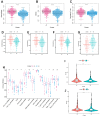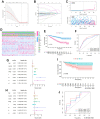TIMP1 shapes an immunosuppressive microenvironment by regulating anoikis to promote the progression of clear cell renal cell carcinoma
- PMID: 37688768
- PMCID: PMC10522382
- DOI: 10.18632/aging.205005
TIMP1 shapes an immunosuppressive microenvironment by regulating anoikis to promote the progression of clear cell renal cell carcinoma
Abstract
Background: The association between ccRCC and Anoikis remains to be thoroughly investigated.
Methods: Anoikis-related clusters were identified using NMF. To identify prognostic anoikis-related genes (ARGs) and establish an optimal prognostic model, univariate Cox and LASSO regression were employed. The E-MTAB-1980 cohort was utilized for external validation. Multiple algorithms were used to evaluate the immune properties of the model. GO, KEGG and GSVA analyses were employed to analyze biological pathway functions. qRT-PCR was employed to measure RNA levels of specific genes. Cell Counting Kit-8, wound healing, and Transwell chamber assays were performed to determine changes in the proliferative and metastatic abilities of A498 and 786-O cells.
Results: Based on the expression of 21 prognostic ARGs, we constructed anoikis-related clusters with different prognostic and immune characteristics. The cluster A1 showed a worse prognosis, higher infiltration of immunosuppressive cells and enrichment of several oncogenic pathways. We also calculated the Anoikis Index (AI). Patients in high AI group had a worse prognosis, higher infiltration of immunosuppressive cells and higher expression of immunosuppressive checkpoints. TIMP1 exerted a tumor-promoting role in ccRCC and was significantly associated with immunosuppressive cells and checkpoints. The downregulation of TIMP1 negatively regulated ccRCC cell proliferation and metastasis.
Conclusions: ARGs played crucial roles in tumorigenesis and progression and were positively associated with a poor prognosis. AI had great accuracy in predicting the prognosis and immune characteristics of ccRCC patients. TIMP1 was significantly associated with clinicopathological variables and the immunosuppressive microenvironment, which could be exploited to design novel immunotherapies for ccRCC patients.
Keywords: TIMP1; anoikis; anoikis index; ccRCC; tumor microenvironment.
Conflict of interest statement
Figures









Similar articles
-
Deciphering anoikis resistance and identifying prognostic biomarkers in clear cell renal cell carcinoma epithelial cells.Sci Rep. 2024 May 27;14(1):12044. doi: 10.1038/s41598-024-62978-0. Sci Rep. 2024. PMID: 38802480 Free PMC article.
-
Identification and validation of prognostic and tumor microenvironment characteristics of necroptosis index and BIRC3 in clear cell renal cell carcinoma.PeerJ. 2023 Dec 18;11:e16643. doi: 10.7717/peerj.16643. eCollection 2023. PeerJ. 2023. PMID: 38130918 Free PMC article.
-
Establishment and validation of a novel anoikis-related prognostic signature of clear cell renal cell carcinoma.Front Immunol. 2023 Mar 28;14:1171883. doi: 10.3389/fimmu.2023.1171883. eCollection 2023. Front Immunol. 2023. PMID: 37056778 Free PMC article.
-
Integrated single-cell and bulk characterization of branched chain amino acid metabolism-related key gene BCAT1 and association with prognosis and immunogenicity of clear cell renal cell carcinoma.Aging (Albany NY). 2024 Feb 2;16(3):2715-2735. doi: 10.18632/aging.205506. Epub 2024 Feb 2. Aging (Albany NY). 2024. PMID: 38309289 Free PMC article.
-
Anoikis resistance regulates immune infiltration and drug sensitivity in clear-cell renal cell carcinoma: insights from multi omics, single cell analysis and in vitro experiment.Front Immunol. 2024 Jun 17;15:1427475. doi: 10.3389/fimmu.2024.1427475. eCollection 2024. Front Immunol. 2024. PMID: 38953023 Free PMC article.
Cited by
-
Deciphering anoikis resistance and identifying prognostic biomarkers in clear cell renal cell carcinoma epithelial cells.Sci Rep. 2024 May 27;14(1):12044. doi: 10.1038/s41598-024-62978-0. Sci Rep. 2024. PMID: 38802480 Free PMC article.
-
Assessing the role of programmed cell death signatures and related gene TOP2A in progression and prognostic prediction of clear cell renal cell carcinoma.Cancer Cell Int. 2024 May 10;24(1):164. doi: 10.1186/s12935-024-03346-w. Cancer Cell Int. 2024. PMID: 38730293 Free PMC article.
-
In silico research of coagulation- and fibrinolysis-related genes for predicting prognosis of clear cell renal cell carcinoma.Transl Androl Urol. 2025 Feb 28;14(2):307-324. doi: 10.21037/tau-24-483. Epub 2025 Feb 25. Transl Androl Urol. 2025. PMID: 40114841 Free PMC article.
-
Identification and validation of prognostic and tumor microenvironment characteristics of necroptosis index and BIRC3 in clear cell renal cell carcinoma.PeerJ. 2023 Dec 18;11:e16643. doi: 10.7717/peerj.16643. eCollection 2023. PeerJ. 2023. PMID: 38130918 Free PMC article.
-
Prognostic impact and immunotherapeutic implications of NETosis-related prognostic model in clear cell renal cell carcinoma.J Cancer Res Clin Oncol. 2024 May 27;150(5):278. doi: 10.1007/s00432-024-05761-y. J Cancer Res Clin Oncol. 2024. PMID: 38801430 Free PMC article.
References
-
- Li Y, Lih TM, Dhanasekaran SM, Mannan R, Chen L, Cieslik M, Wu Y, Lu RJ, Clark DJ, Kołodziejczak I, Hong R, Chen S, Zhao Y, et al., and Clinical Proteomic Tumor Analysis Consortium. Histopathologic and proteogenomic heterogeneity reveals features of clear cell renal cell carcinoma aggressiveness. Cancer Cell. 2023; 41:139–63.e17. 10.1016/j.ccell.2022.12.001 - DOI - PMC - PubMed
-
- Yu Z, Lv Y, Su C, Lu W, Zhang R, Li J, Guo B, Yan H, Liu D, Yang Z, Mi H, Mo L, Guo Y, et al.. Integrative Single-Cell Analysis Reveals Transcriptional and Epigenetic Regulatory Features of Clear Cell Renal Cell Carcinoma. Cancer Res. 2023; 83:700–19. 10.1158/0008-5472.CAN-22-2224 - DOI - PMC - PubMed
Publication types
MeSH terms
Substances
LinkOut - more resources
Full Text Sources
Medical
Research Materials
Miscellaneous

